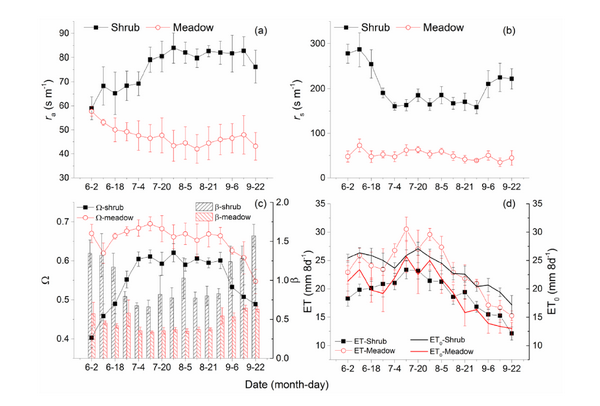Quantified for alpine catchments with different vegetation types. This paper presented a multi-year time series of evapotranspiration (ET) and water supply (precipitation minus ET) during the warm-season (June to September), measured using eddy covariance techniques for an upper alpine shrub (3400 m) and for a lower alpine meadow (3200 m), on the northeastern Qinghai-Tibetan Plateau. The monthly ET for the shrub averaged 71.8 ± 10.1 mm (Mean ± SD), which was 22.7% lower than for the meadow. ET peaked at 89.0 ± 3.0 mm for the shrub and at 113.9 ± 2.6 mm for the meadow both in July. The monthly water supply was nearly neutral from June to July and represented a surplus in August and September at both sites. The mean warm-season ET and water supply were 287.0 ± 17.6 mm and 59.6 ± 16.3 mm for the shrub, and 352.2 ± 15.7 mm and 22.5 ± 32.5 mm for the meadow, respectively. Piecewise structural equation models showed that variability of daily ET was dominated more by net radiation (Rn) than by vapor pressure deficit (VPD) at both sites. However, net radiation was 32.6% higher for the shrub than for the meadow, but this did not drive higher ET for the shrub. This was explained by the difference in the energy partitioning strategy (Bowen ratio), which was attributable to the difference in the bulk surface resistance, rather than the difference in the climatological resistance (which is proportional to VPD/ Rn). The seasonal and annual variability of water supply was determined by precipitation rather than by ET. The linear slopes of water supply with precipitation were all close to one, regardless of vegetation type. This suggested that the water yield efficiency was consistent at the two sites. Our results highlighted the different effects of vegetation type on ET and water supply for humid alpine regions. The lower ET loss and consequent higher water yield, but with less digestible forage in the shrub, would present a dilemma for the balance between water supply and forage production under current shrub expansion in alpine rangeland.
This result was published in Agricultural and Forest Meteorology with the title of "Precipitation rather than evapotranspiration determines the warm-season water supply in an alpine shrub and an alpine meadow".
The link below will guide you to the reading:
https://www.cell.com/stem-cell-reports/fulltext/S2213-6711(20)30376-3

Fig. 2. Mean seasonal variations of aerodynamic resistance (ra, a), bulk surface resistance (rs, b), decoupling coefficient (Ω, c) and Bowen ratio (β, c), and
evapotranspiration (ET, d) and reference ET (ET0, d) in the shrub and the meadow.
